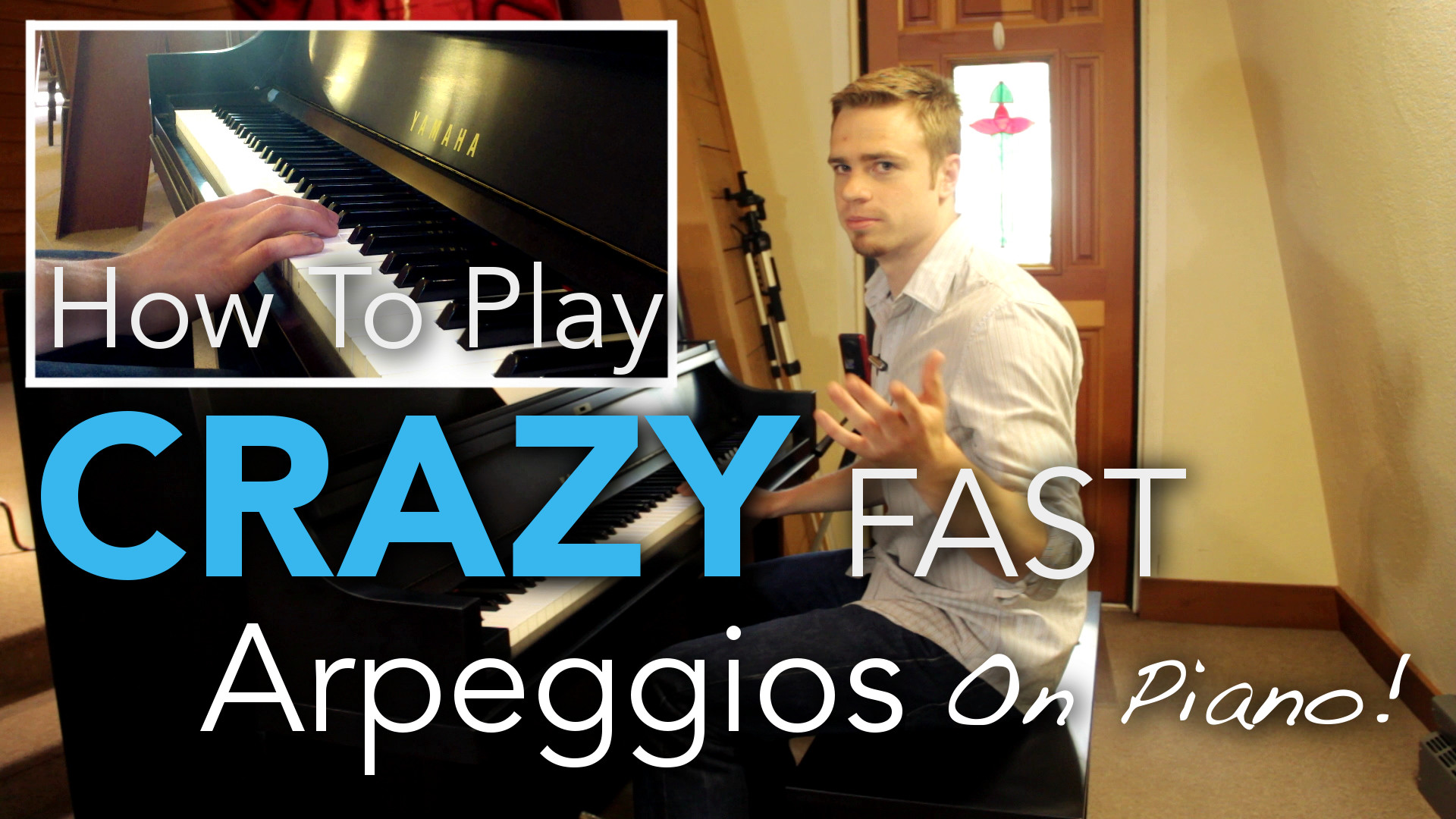This is probably the flashiest piano move I know. Crazy fast piano arpeggios. It looks sweet and sounds cool, and it’s actually a lot easier than it seems. And honestly you could probably learn it in a month with just 5 to 10 minutes a day of practice.
So in this tutorial, I’m going to show you how to learn this step by step in four parts:
- Notes/Fingerings
- Technique
- Practice Strategies
- Complete Practice Routine
(Quick note: if you want the FULL lesson on these crazy-fast piano arpeggios, there’s even more info in lesson 12 of the free Become a Piano Superhuman course. Yep, it’s really 100% free, you can sign up here.)
Make sure you read through all four steps, it will save you a lot of time learning it and you’ll learn it a lot better. Oh, and I have a video that explains it pretty in depth too if you learn better that way:
Part 1:
Part 2:
1. Notes/Fingerings:
The notes are actually pretty easy, it’s simply the root, third, fifth of each chord. So for example on a C Major chord it would look like this:
LH: C3 E3 G3 RH: C4 E4 G4 LH: C5 E5 G5 RH: C6 E6 G6 C6 G6 E6 C LH: G5 E5 C5 RH: G4 E4 C4 LH: G3 E3 C3For the right hand you have to use 1,2,3 for the fingering so that you can hit that top C with your pinky. For the left hand, you can either use 5,3,1 or 4,2,1 whatever is more comfortable. But either way, make sure you use the same fingering every time so you can drill in the muscle memory.
2. Technique:
Using good technique is important for a few reasons:
- You can play faster
- It will sound smoother
- It prevents injury
So if you want to get this solid and fast, practice with this technique every time, even when you’re practicing slowly. So here it is:
Whenever you mover your arm away from your body (LH moving to the left or RH moving to the right) you want to move your wrist down in away in a semicircle shape (or a “U” shape). Whenever your arm is moving the other way, you want to move it up and in (an inverted “U” shape). It might be easier to just watch the video, its probably better to see the technique than to read about it.
When you’re practicing, exaggerate the movements at first. It’s easier to tone it down later, but you’ll learn it better at first if you exaggerate.
3. Practice Strategies for Piano Arpeggios:
I wouldn’t practice these type of piano arpeggios more than 5 to 10 minutes a day, but when you do practice it, USE THESE STRATEGIES! Trust me, they’ll save you a ton of time.
a. Rhythms
If you don’t know how to practice in rhythms (also called groups) yet its probably the number one thing you should start doing, they help you drill in muscle memory crazy fast compared to any other method IMO.
To practice in rhythms, play through the exercise first with the rhythm “Short short long” (quarter, quarter, eighth). Play it a couple times through. Then play it a couple times using the rhythm “Short long, short” (quarter, eighth, quarter). Finally use the rhythm “Long, short short” (quarter, eighth, eighth).
This basically breaks down the entire run into groups of three notes so your brain has time to concentrate on each set. It helps a tonnnn. If you want to see it in action, just watch the video at the beginning of this post.
b. Chords
Simply play the entire passage as 3 note chords (so press all the notes in a hand down at the same time). This helps your brain focus on groups of notes so it has less to memorize. Instead of memorizing 24 notes you only have to remember 8 chords.
Once you start getting good at this, focus on increasing the speed of the horizontal movement (quickly moving your arm to the side), as that’s usually the hardest part of the run.
c. Metronome
Start off at a ridiculously slow tempo. Like annoyingly slow. You want to get it perfect to start off. Play through 2 to 4 times then up your metronome by 3 clicks (around 12 bpm). Do it again 2 to 4 times. Keep bumping your metronome up until you hit a point where you start making mistakes. Really focus and try a couple more times to get it right at this new tempo, then always end by cranking it down slow for a couple reps. THIS IS SUPER IMPORTANT. Your brain remembers the last thing you do more than the rest, so the last repetition must be FLAWLESS. So crank the tempo down slow enough where you can do it absolutely perfectly.
4. Complete Practice Routine
If I was to learn this all over again, here’s how I’d learn it to make the most of my time:
1. Set a timer for 10 minutes (actually do this, don’t just estimate your time)
2. Do 4 repetitions of each rhythm
3. Do 8 repetitions of playing in chords
4. Do 3 repetitions at each metronome setting
5. Repeat steps 2 through 4 until timer goes off
6. Finish off with 3 repetitions at a slow tempo, and get it perfect
Hope that helps you out, if you have any questions always feel free to leave a comment below or as always you can email me at zach@bestpianotips.com. Oh, and don’t forget to send me videos of you playing your crazy fast piano arpeggios 🙂
-Zach




Hi Zach,
You taught this lesson on arpeggios with clarity and at a speed that was so easy to follow. Your explanations were clear and detailed and totally understood!!
Thank You!!
My brain doesn’t always think as quickly as I need it to or my fingers do not hit the keys quickly enough, especially when jumping from a line to a space that is 2 spaces away from the line or from a space to a line that is 2 lines away from the space.
Also, my worst problem is with fingering,using the correct fingers to move to and from other notes, especially in classical music. I need to sight read quicker.
Hi Zach, thank you for this article and video it is really very helpful. Can you please email me the notes for more advanced swipped arpeggio like the one you are playing at the begging of the video. Thanks à lot. Ella
Am really awed! Plus some really great techniques for learning. Tnx so much for dis tutorial Zach!